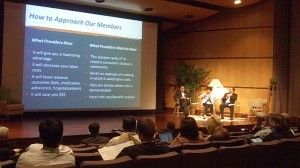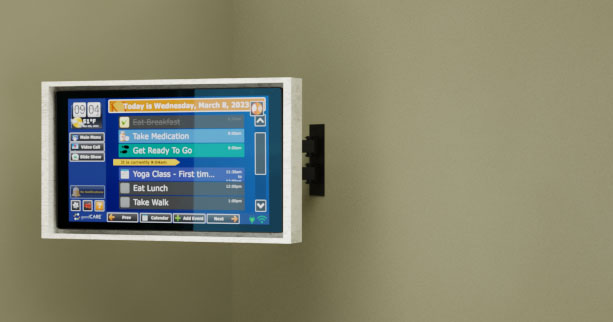12 Healthcare Companies Achieve Finalist Status for Innovations in HealthcareSM ABBY Awards
— 13th Annual Awards Event to be held September 28, 2011

Santa Ana, CA, July 11, 2011 – The Adaptive Business Leaders (ABL) Organization has announced the names of 12 innovative healthcare companies which have been selected as Finalists for the 2011 ABBY Awards. The ABBYs will be presented at the 13th Annual Innovations in HealthcareSM Awards Event, on September 28, 2011. The ABBY Awards honor companies, selected from throughout North America, which have developed ways to lower the cost of providing quality healthcare through their medical or information technologies, or innovative approaches to the delivery of healthcare.
The 12 Finalists– three each in each of the four categories – were selected by a Committee composed of ABL Members who are C-level healthcare executives with deep domain knowledge in each of the Award areas. “In this, our 13th year of selecting Finalists for the ABBY Awards, the Committee was truly impressed with the caliber of all the nominees, representing companies from throughout North America,” noted Mimi Grant, President of the ABL Organization. “Not only are they all innovative, they have convincingly demonstrated that they are currently in use in the United States, and have clinical and financial metrics that prove their product or service reduces the cost of providing quality care.”
Four ABBY Award Winners will be selected via secret ballot by the healthcare executives attending the September 28 Event, after viewing presentations made by the CEO representing each Finalist company. Attendance is open to ABL Members and their guests, as well as non-Member senior executives of healthcare providers and payers, health IT, medical technology, and services firms. Details about the Innovations in HealthcareSM Awards Event, to be held at the Marriott Hotel, in Long Beach, CA, can be found at http://www.abl.org/IIH.htm
Finalists in the “Healthcare Information and/or Telecommunications Technology – Consumer-Facing” category are:
 Westbend, WI-based GrandCare Systems provides a telecommunications system that enables individuals to remain independent and at home by remotely assessing their activities of daily living and managing their chronic health conditions. It also offers virtual communication and visits with family and caregivers via two-way web conferencing, and stimulates brain activity and fitness with such activities. GrandCare Systems helps relieve individuals’ feelings of isolation and gives caregivers peace of mind.
Westbend, WI-based GrandCare Systems provides a telecommunications system that enables individuals to remain independent and at home by remotely assessing their activities of daily living and managing their chronic health conditions. It also offers virtual communication and visits with family and caregivers via two-way web conferencing, and stimulates brain activity and fitness with such activities. GrandCare Systems helps relieve individuals’ feelings of isolation and gives caregivers peace of mind.
Boulder Creek, CA’s HeartMath’s Revitalize You! Resilience Training program provides a video-based online course for organizations and consumers, teaching how to maximize heart-brain communication for increased physiological well-being and cognitive performance. Research has shown that the heart is a primary generator of body rhythms and powerfully influences brain processes that control the nervous system, cognitive function, and emotion.
Toronto, Ontario, Canada’s IDEAL LIFE is a multinational company that delivers secure, reliable remote health management solutions for individuals with chronic conditions – on demand, to any location – accessible through major brands of cell phones, computers, and other devices. The FDA-approved products are wireless, easy-to-use, and affordable, with an open technology platform that supports customization and integration with existing information-based systems, including electronic medical records.
Finalists in the “Healthcare Information and/or Telecommunications Technology – Business-Facing” category are:
Houston, TX-based Blausen Medical Communications has developed and deployed the Blausen Human Atlas app for smartphones and tablets, utilizing its world’s-largest library of 3D medical animations. Doctors and nurses use the app, at the point of care, to explain often-complex medical concepts to patients. The app contains 300+ topics covering medical conditions and treatments, with easy-to-understand animation and narration. Clinicians report that using the Blausen app has resulted in better-informed, less-anxious, and more treatment-compliant patients and their families.
San Mateo, CA’s Extend Health, which operates the largest private Medicare-focused health insurance exchange in the U.S., developed its patent-pending call center solution, Complemax, to shorten average telephone hold times for its customers, while maximizing agent utilization. Using an innovative algorithm, Complemax matches the calling customer’s location and profile with an agent who holds appropriate credentials to provide service – i.e., state licensure, insurance company appointments, and certification to sell specific products in that region.
Irvine, CA’s PathCentral, Inc. offers a scalable web-based anatomic pathology laboratory information system that seamlessly integrates all of the critical components of a pathology practice’s day-to-day operations into a single platform. PathCentral’s system quickly and inexpensively interfaces with hospital electronic medical records, doctors’ offices, and a wide range of laboratory instrumentation. It reduces costs through improvements in operating efficiencies and enhances patient safety using state-of the art specimen identification and tracking.
Finalists in the “Medical Device” category are:
Cleveland, OH’s Chart SeQual Technologies’ Eclipse 3 Personal Ambulatory Oxygen System provides reliable continuous flow and pulse dose options in a 24/7 portable device that satisfies both stationary and ambulatory oxygen needs. Eclipse 3 lowers operational costs by reducing monthly deliveries and simplifying inventory management and space; it also uses less electricity than traditional stationary concentrators. Clinically, studies have shown that active oxygen therapy patients have 80% fewer hospitalizations than inactive patients.
Austin, TX-based Vermillion, Inc.’s OVA1 is the only FDA-cleared blood test intended to help physicians identify the likelihood of a woman’s ovarian mass being malignant prior to surgery, thus facilitating her referral to the most appropriate specialist (i.e., a gynecologic oncologist) for her initial surgery. Incorporating OVA1 into physicians’ preoperative assessment may also help reduce the number of second surgeries, therefore reducing overall healthcare costs.
South San Francisco, CA’s VitalWear’s VitalWrap System provides heating, cooling, and compression through a family of body-part-specific therapeutic wraps, combined with a base unit and tubing set. This continuous thermal therapy reduces pain and dependency on pain medication, and minimizes tissue damage and scarring. In an orthopedic rehabilitation field study, VitalWrap was shown to reduce recovery time in half.
Finalists in the “Approaches to the Delivery of Healthcare” category are:
Aliso Viejo, CA-based CareMeridian’s continuum of post-acute care and rehabilitation options to people with life-altering injuries (i.e., brain, spinal cord) and medically complex illnesses, merges a skilled healthcare team with state-of-the-art technology in community-based settings. With over 1,400 admissions and discharges in recent years, CareMeridian has experienced successful outcomes in 96% of those cases, returning one-third of its short-term admissions directly home and another 40% to acute rehab environments for intense therapy prior to the ultimate discharge home. The company’s 44-day average length of stay is less than half of the benefit days that most patients have in their long-term care plan.
San Fernando, CA’s Partners in Care Foundation Institute for Change developed and disseminated the In-Home Palliative Care (IHPC) program in collaboration with Kaiser Permanente, providing home visits to patients with serious chronic illnesses and an estimated life expectancy of one year. The IHPC significantly reduced ER visits (20% for those receiving the intervention vs. 33% of usual care patients), hospitalizations (36% vs. 59%), and hospital use by 4.36 days. Overall costs of care were 33% lower for those receiving the intervention, and the average cost per day was $117.50 lower ($95.30 vs. $212.80) than for the usual treatment group.
Dallas, TX-based Teladoc, Inc. provides access to U.S.-based, board-certified physicians, 24/7/365, via telephone or videoconferencing, for a variety of medical issues, offering an affordable and convenient alternative to using an ER or urgent care facility. Teladoc patients receive a response from a highly-qualified physician within an average of 22 minutes; the average consultation lasts 12 minutes and costs about $38. Teladoc’s solution reduces patients’ workplace absenteeism and presenteeism, and alleviates the strain on urgent care providers. The service is covered by many employers and healthcare plans in an effort to drive down their own healthcare costs.
Semi-Finalists
The Semi-Finalists for the 2011 ABBY Awards were – in the HIT-Business category: BioStorage Technologies, Inc. (Indianapolis, IN); CareCloud (Miami, FL); eBridge Inc. (Tampa, FL); Happtique, Inc. (New York, NY); Informatics Corporation of America (Nashville, TN); Mitochon Systems (Newport Beach, CA); NaviNet (Boston, MA); NetChemistry (Newport Beach, CA); Quality Systems, Inc. (Irvine, CA); and Sajix Inc. (Pleasanton, CA). In the HIT-Consumer category: CaringBridge (Eagan, MN); Conceptus, Inc. (Mountain View, CA); Healthagen, LLC (Lakewood, CO); Pharos Innovations (Northfield, IL); and RememberItNow! (Orinda, CA). In the Medical Device category: Cobalis Corporation (Irvine, CA); Hartwell Medical (Carlsbad, CA); Lerner Medical Devices, Inc. (Los Angeles, CA); Masimo Corporation (Irvine, CA); SI-BONE, Inc. (San Jose, CA); and Vertos Medical, Inc. (Aliso Viejo, CA). And, in the Approach to the Delivery of Healthcare category: AccessOC (Laguna Hills, CA); Catholic Healthcare West + Blue Shield of California + Hill Physicians (Northern California); Forefront TeleCare, Inc. (Emeryville, CA); MediCall (Pleasanton, CA); Private Health Management (Los Angeles, CA); Satori World Medical, Inc. (San Diego, CA); and The Orthopedic Clinic Association (Phoenix, AZ).
Past ABBY Award Winners
Past ABBY Award nominees and winners have included companies that have made breakthroughs and transformative advances in medical devices, diagnostics, therapeutics, information technology, and electronic solutions, as well as organizations that have applied innovative systems and technology to providing care and coverage, decreasing the numbers of uninsured, and engaging healthcare consumers more actively in their care and health status. Specifically: A-Life Medical; Accuray, Inc.; Alameda County Medical Center; Aperio; BeWell Mobile Technology Inc.; Blue Shield of California; Care Level Management; Dakim, Inc.; Diversa Corporation; eHealth, Inc.; Epocrates Inc.; eV3, Inc.’s Neurovascular Division; FoxHollow Technologies, Inc.; Gen-Probe, Inc.; Health Allies; Health Hero Network, Inc.; I-Flow; IPC – The Hospitalist Company; InSight Health Services; InTouch Health; Kaiser Permanente’s eHealth Initiatives; M*Modal, Inc.; Masimo Corporation; Memorial Health Services; Osmetech Molecular Diagnostics; Refractec; Santa Clara Family Health Plan; Silverado Senior Living Center; Specialists On Call; Sutter Health’s eICU; Trizetto Group; Vocera Communications; VQ OrthoCare; and WorkWell Systems, Inc.
About the Adaptive Business Leaders Organization:
ABL supports the needs of its Member CEOs by providing a place for top-level executives to draw on the experience, knowledge, and skill sets of their healthcare and technology industry peers in a vertical industry, personal advisory board setting. Members meet monthly in Round Tables, as well as near-monthly in workshops and conferences to hear from cutting-edge experts, to exchange ideas, and connect with other chief executives. ABL’s CEO Round Table program is offered throughout California: in Greater Los Angeles, Orange, San Diego, San Francisco, and Santa Clara Counties. More information can be found at http://www.abl.org and http://www.abl.org/IIH.htm. Contact: Laura Grant, Events Director, at 714/245-1427 or Mimi Grant, President, at 714/245-1425 # # #
 …
…

















